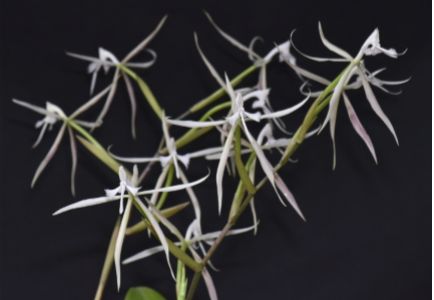

Epidendrum esperanza-mejiae Hágsater & Uribe Vélez 2018 GROUP Coilostylis
Photo by Carlos Uribe V./TYPE drawing by R. Jiménez M. © courtesy of Eric Hagsater and Icones Orchidacearum 16(1): t. 1617 Hagsater etal 2018



Common Name Esperanza Mejia's Epidendrum [Colombian Orchid Enthusiast current]
Flower Size 4" [10 cm]
Presumably found in Colombia without locational data, but plant cultivated at an elevations of 1200 meters as a medium sized, cool growing epiphyte with a simple, somewhat thickened and fusiform, heteroblastic pseudobulb covered in youth by 4 to 6, papiraceous sheaths and carrying 2, at the apex of the pseudobulb, coriaceous, articulate, blade elliptic, acute, margin entire, spreading, green leaves that blooms in the spring on a terminal, apical, produced from the mature pseudobulb, racemose, distichous; peduncle 6.8 to 8.8" [17 to 22 cm] long, terete, covered by 4 to 5, imbricate, acute, closely appressed and embracing the peduncle tubular bracts, peduncle 1.32 to 1.48" [3.3-3.7 cm] long, rachis terete, thin, straight, slightly arched, 14.8" [37 cm] long including the flowers, simultaneously 5 to 7 flowered inflorescence with somewhat shorter than the ovary, conduplicate at the apex, acuminate floral bracts and carrying resupinate flowers withut fragrance data.
" Epidendrum esperanza-mejiae belongs to the GROUP Coilostylis which is characterized by the sympodial, caespitose plants, the stems forming a fusiform pseudobulb with an apical, racemose, distichous inflorescence, the peduncle covered by large bracts (but not spathaceous bracts), and large, star-shaped flowers with long, narrow sepals and petals. The species is recognized by the canelike, barely thickened stems, 2 apical leaves, the inflorescence with an elongate peduncle somewhat longer than the leaves, flowers entirely white, including the calli, petals arched, and the lateral lobes of the lip obliquely semi-ovate, the inner margin a convex arch. Epidendrum ciliare L. is widely distributed from western Mexico (Nayarit) to Peru and Brazil and the Antilles, produces the inflorescence from the immature, more elongate pseudobulb, but the outer margins of the lateral lobes of the lip are deeply fimbriate, and the inner margin is straight, not strongly concave. Epidendrum megalemnum Carnevali & G.A.Romero ranges from the lesser Antilles and northern South America, flowers from the mature stem and the base of the inflorescence is enveloped in 5-10 imbricating, conduplicate bracts, shares the same shape of the lip with E. ciliare, which is sympatric. Epidendrum sandiorum (Hágsater, Karremans & L.Sánchez) Hágsater, Karremans & L.Sánchez has sub-spherical to ovoid pseudobulbs with a single apical leaf, the inflorescence produced from the immature stem, 3-lobed lip with the outer margin of the lateral lobes fimbriate to laciniate, and the .18" [45 mm] long mid-lobe is trullate beyond the middle, the apex long-acuminate, the margin erose. Epidendrum oerstedii Rchb.f. ranges from Honduras to central Panama, produces the inflorescence from the immature, short pseudobulb, the margins of the lip are entire and the mid-lobe is shorter 1 to 1.32" [25 to 33 mm] long, widened beyond the middle." Hagsater etal 2018
Synonyms
References W3 Tropicos, Kew Monocot list , IPNI ; * Icones Orchidacearum 16(1): t. 1617 Hagsater etal 2018 drawing/photo fide; Icones Orchidacearum 16[1] Plate 1641 Hagsater & Sanchez 2018 see recognition section
--------------------------------------------------------------------------------------------------------------------------